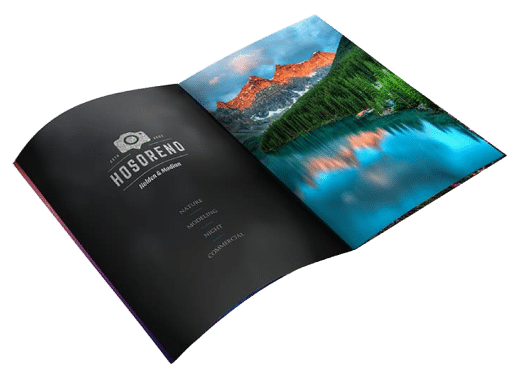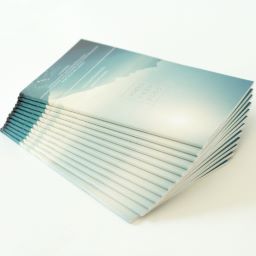Maximizing ROI with Multi-Purpose Booklet Printing Designs
Maximizing ROI with Multi-Purpose Booklet Printing Designs
Blog Article
The Essential Guide to Comprehending Booklet Printing Options and Techniques
The procedure of brochure printing involves numerous factors to consider that can greatly affect the last item. From picking the ideal style and dimension to understanding the nuances of binding techniques, each option plays a crucial duty. Furthermore, elements such as paper stock and printing methods more affect the efficiency of the brochure. As one browses these options, it comes to be necessary to grasp how they interconnect and what that means for the total end result.
Comprehending Pamphlet Formats and Sizes
When thinking about pamphlet printing, understanding the numerous formats and sizes readily available is necessary for accomplishing the wanted discussion. Booklets can be generated in various formats, including saddle-stitched, spiral-bound, and perfect-bound, each offering unique benefits. Common sizes vary from standard letter (8.5 x 11 inches) to smaller sized options like A5 (5.8 x 8.3 inches), enabling adaptability based on content and target audience.Selecting the appropriate size can influence both the design and visitor involvement. Larger sizes might match aesthetically driven content, while smaller sized formats may be extra easy to use and portable. Additionally, the number of web pages impacts the option of binding technique, as thicker booklets may call for sturdier bindings. Eventually, comprehending these facets permits an extra tailored method, making sure that the end product lines up with the designated message and visual, boosting the total performance of the communication.
Picking the Right Paper Stock

Binding Approaches: Options and Considerations
When it pertains to binding approaches for booklets, several alternatives are offered, each with unique benefits. Saddle stitch binding offers a cost-effective solution for thinner booklets, while excellent binding techniques offer an even more refined search for thicker publications. Wire-O binding stands apart for its sturdiness and simplicity of usage, making it suitable for papers that need flexibility.
Saddle Stitch Binding
Saddle stitch binding provides a practical and cost-efficient service for setting up pamphlets, making it a prominent option amongst authors and businesses. This binding approach includes folding sheets of paper in half and stapling them along the fold line, creating a organized and cool look. Generally suitable for brochures with a lower web page matter, saddle sewing is ideal for publications, pamphlets, and instructional materials. The simpleness of this technique permits quick production and is often favored for advertising products or short runs. It is important to note that saddle stitch binding might not be ideal for thicker brochures, as the spine may not hold up under raised weight. Generally, it continues to be a dependable alternative for several printing projects.
Perfect Binding Techniques
Perfect binding is an extensively utilized method that offers a specialist and refined surface to magazines and booklets. This technique includes gluing the pages with each other at the spinal column using a solid adhesive, allowing for a clean side and the ability to hold a bigger variety of pages compared to saddle sewing. Perfect binding is specifically ideal for thicker booklets, such as brochures and yearly records, where a sturdy, flat back is preferred. In addition, it offers the option for a published cover that can be created to boost visual allure. Factors to consider such as page count, paper weight, and the intended use of the booklet must be taken into account, as they can influence longevity and overall top quality.
Wire-O Binding Alternatives
Wire-O binding, understood for its resilience and adaptability, offers an excellent choice for brochures that require very easy page turning and a specialist look. This binding approach uses a collection of steel loops that hold pages safely, allowing them to lie flat when open. It is particularly appropriate for brochures, handbooks, and discussions as a result of its robust nature. Wire-O binding is readily available in various shades and sizes, accommodating various web page matters and thicknesses. Furthermore, it allows the incorporation of tabs and covers, enhancing the pamphlet's general aesthetic. Considerations for Wire-O binding consist of the selection of cord color, the size of the loopholes, and the degree of customization preferred, all of which can exceptionally influence the end product's appearance and performance.
Digital vs. Offset Printing: Which Is Best for You?
When selecting a printing approach for brochures, comprehending the differences between digital and balance out printing is important. Digital printing uses modern-day technology to generate top quality prints quickly Extra resources and affordably, making it ideal for short runs or jobs needing fast turnaround times. It permits for customization, giving the ability to publish on-demand with marginal waste.In contrast, offset printing is a traditional approach that masters generating why not check here big amounts with constant quality. It entails moving ink from a plate to a rubber covering, after that to the paper, which leads to vivid colors and exact details. Balance out printing commonly calls for longer arrangement times and is extra cost-efficient for bigger volumes.Ultimately, the choice in between electronic and counter printing depends on task demands, budget plan, and preferred quantity. For tiny, time-sensitive projects, digital could be the very best option, while balanced out may be better for bigger, premium productions.

Designing Your Pamphlet: Tips and Finest Practices
When developing a brochure, careful attention to format, font selection, and color usage can significantly improve its effectiveness. A well-structured format guides the viewers's eye, while suitable font styles guarantee readability and convey the wanted tone. In addition, reliable use color can stimulate emotions and emphasize essential details, making the overall style a lot more impactful.
Picking the Right Layout
Just how can one properly select the best design for a brochure? First, it is necessary to review the brochure's function and target market. A tidy, arranged layout improves readability and involvement. Making use of a grid system can aid in straightening elements constantly, developing an expert appearance. Furthermore, incorporating aesthetic power structure with differing dimensions and placements of images and message can direct the visitor's eye and emphasize essential information. It is additionally crucial to leave enough white room, which avoids congestion and permits far better focus. Checking different formats via mock-ups can offer understanding right into how the layout executes in real-world situations, ensuring that the last product fulfills both aesthetic and functional needs. Useful Picking Proper Font Styles
An appropriate font can substantially improve the general design of a booklet, complementing the layout and enhancing the content's message. The choice of font styles ought to take into consideration readability, especially for body message, as it assures the information comes to all readers. Sans-serif typefaces are frequently liked for digital formats, while serif fonts can offer a typical feeling in published materials. It's recommended to limit font choices to 2 or 3 to keep visual coherence. In addition, typeface dimension plays a crucial duty; headings need to be not frustrating yet distinct, while body text ought to be comfortable for analysis. When choosing fonts, placement with the pamphlet's motif and target audience is important for effective interaction and aesthetic allure.
Reliable Use of Color
Shade functions as an effective tool in booklet layout, directing and forming perceptions viewers emotions. It can evoke sensations of enjoyment, trust fund, or peace, depending upon the tones selected. Developers need to take into consideration color theory principles, making certain that the chosen combination lines up with the booklet's message and target market. Utilizing cozy shades like red and orange can develop necessity, while cooler tones like green and blue foster tranquility.Additionally, contrast plays an important function; corresponding shades can boost readability and visual appeal. Consistency in color use across web pages better enhances brand name identity and cohesion. Eventually, efficient color application not only catches attention but additionally reinforces the booklet's objective, making it an important aspect of effective style.
Ending Up Touches: Coatings and Special Impacts
While numerous consider the content and layout of a booklet one of the most essential components, the ending up touches, such as finishes and special effects, play an important role in boosting its total charm. Coatings can offer protection and durability, guaranteeing that the booklet stands up to wear and tear. Matte coatings use a sophisticated, non-reflective surface area, while shiny layers can make colors appear even more captivating and dynamic. Special impacts, like embossing or foil marking, add a tactile measurement that can produce a memorable impact. These methods can highlight specific locations, accentuating vital information or developing visual passion. Furthermore, UV layer can give a high-shine finish that boosts the overall look.Together, these completing touches not only improve the brochure's aesthetic however also communicate expertise and focus to detail, inevitably leaving a long lasting influence on the reader.
Expense Factors To Consider for Booklet Printing
Understanding the different price factors to consider for booklet printing is crucial for companies and businesses aiming to enhance their spending plans. Key elements influencing expenses include the option of ink, binding, and paper approaches. Better materials, such as superior paper or specialized inks, commonly raise the total expense. Additionally, the dimension and page matter of the booklet play a substantial function; larger booklets need even more resources and time to produce.Another vital factor to consider is the printing strategy, whether digital or offset, as each has its own pricing structure and suitability for different quantities. Organizations must additionally consider layout prices, which can differ based upon intricacy and making use of professional services. Inevitably, delivery and handling costs can contribute to the total, see page specifically for huge orders. By reviewing these aspects, organizations can make educated decisions that line up with their monetary abilities while achieving the desired top quality in their published products.
Regularly Asked Inquiries
What Are the Ecological Effects of Booklet Printing?
The ecological influences of brochure printing consist of logging from paper manufacturing, carbon emissions from transport, and waste generation from thrown out materials - Booklet Printing. Sustainable methods, such as using recycled paper and environmentally friendly inks, can mitigate these results
Exactly How Can I Guarantee Shade Precision in My Pamphlet?
To ensure color precision in a brochure, one should make use of adjusted screens, employ specialist color accounts, carry out test prints, and select high-quality printing solutions that provide shade matching and proofing choices for ideal results.
What Is the Typical Turn-around Time for Booklet Printing?
The normal turn-around time for booklet printing differs depending upon the intricacy and quantity - Booklet Printing. Usually, it ranges from a few days to 2 weeks, influenced by variables such as printing approaches and ending up demands
Exist Minimum Order Quantities for Brochure Printing?

Can I Publish Booklets in Several Languages?
Printing pamphlets in numerous languages is feasible. Many printing services offer choices for multilingual or multilingual formats, enabling efficient communication. Careful planning guarantees that develop aspects fit different languages without jeopardizing readability or aesthetic appeals. Additionally, variables such as paper supply and printing strategies more affect the efficiency of the brochure. When thinking about booklet printing, recognizing the numerous layouts and dimensions offered is vital for accomplishing the desired discussion. When picking a printing approach for brochures, comprehending the differences in between electronic and balance out printing is vital. Furthermore, the size and web page count of the booklet play a considerable function; bigger brochures require even more sources and time to produce.Another essential consideration is the printing strategy, whether digital or offset, as each has its own rates structure and viability for various quantities. The ecological effects of pamphlet printing include logging from paper production, carbon exhausts from transportation, and waste generation from discarded products.
Report this page